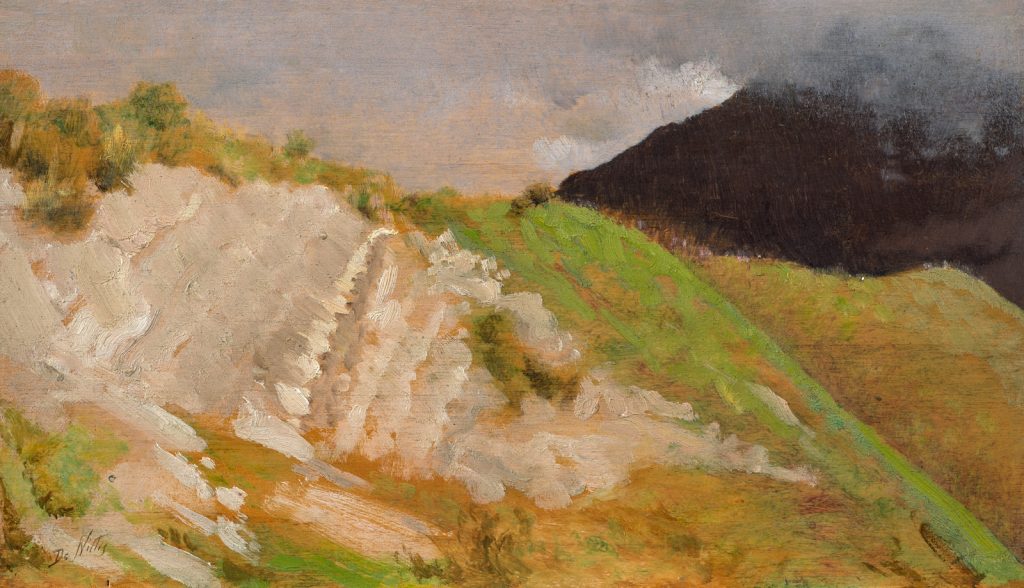Giuseppe De Nittis
(Barletta 1846 - 1884 St.-Germain-en-Laye)
Impressione del Vesuvio, 1872
Oil on panel, 14.4 x 25 cm
Signed lower left De Nittis
Provenance:
Angelo Sommaruga (1857-1941), Paris;
Giovanni Finazzi, Bergamo, 1942;
Calegari, Milan;
Carini, Milan;
Galleria d’Arte Fogliato, Turin;
Umberto Zanatta (1913-90), Turin (label on the verso);
Bottega d’Arte Livorno, Montecatini Terme.
Literature:
Attilio Podestà, Collezione Giovanni Finazzi, Bergamo 1942, fig. 156;
Enrico Piceni, De Nittis, Milan 1955, p. 166;
Alfredo Schettini, La Scuola napoletana, Milan 1960, fig. 56;
Mary Pittaluga and Enrico Piceni, De Nittis, Milan 1963, no. 166;
Pino Dini and G. L. Marini, De Nittis. La vita, i documenti, le opere dipinte, Turin 1990, I, p. 391, no. 404; II, fig. 404.
Giuseppe de Nittis executed a number of studies of Vesuvius between 1871 and 1872 and they occupy an important position in his oeuvre. They rank among his most ambitious and modern works. He was already an established painter when he set off from Paris in autumn 1870 on a brief visit to his native Italy with his wife. The outbreak of the Franco-Prussian War in the same year prolonged his visit and it was almost three years before he could return to Paris. He lodged for a time in Naples before moving to Resina, a small village in a picturesque setting on the slopes of Vesuvius where he lived until 1873. Here, far from the city, he could draw inspiration from nature and return to landscape painting, the preferred genre of his early career. The fascination of Vesuvius – then entering a period of renewed activity – quickly captured his imagination. The volcano became the main focus of his work and a source of constantly changing motifs.
For a twelve-month period between 1871 and 1872 he made daily ascents and descents on horseback, filling a diary – his taccuino1 – with a meticulous day-to-day record of his impressions. The diary gives an animated and entertaining account of his experiences and also documents his interest in volcanic activity. As a daily observer of the volcano he was able to witness the major eruption of April 26, 1872. In these twelve months he produced an important group of small-format plein-air studies documenting the bellezza selvaggia [wild beauty] of nature. Almost all these studies are in oil on panel and show him working highly methodically towards a new formal and chromatic synthesis of his techniques as a landscapist. They are unmatched in Italian painting of the period.2 Whereas previously it had been common practice, for example among artists like Volaire, Wright of Derby, Catel, Fabris and Hackert, to produce theatrical images of the eruptions of Vesuvius as spectacular mementos for Grand Tour travelers, De Nittis concentrated on the rich diversity of changes in weather and light conditions. In his oil sketches he developed a predilection for unconventional viewpoints and close-up images, and a fascination for light and color.
In the present oil sketch De Nittis leads the viewer up a grassy ridge on the lower slopes of the volcano. At the right, dark clouds partly obscure the view of the Gran Cono. Striking contrasts between the green of the grass, the sandy tone of the earth and the powerful black of the cone invigorate the composition. In the upper part of the sky and some areas of the meadow paint is so sparingly used that the surface of the panel gleams through and allows the brown ground to function as a compositional device. The loose modelling of the foreground in broad strokes of fluid, rapidly applied paint is a hallmark of his style. The free, almost abstract handling of parts of the composition has a distinctly modern quality and the spontaneity and delicacy of the work testify to his mastery of plein-air oil sketching techniques.
De Nittis is one of the leading Italian painters of the nineteenth century. He took up his studies at the Istituto di Belle Arti in Naples but abandoned the academic tradition of his training early on. He came into contact with a group of young, mainly Florentine painters known as the Macchiaioli, a name originally attributed to them by a critic as a term of ridicule. Following their example he began to practice plein-air painting. He moved to Paris in 1868 and quickly made his name in artistic circles. In 1874, he participated in the Impressionists’ first group exhibition staged in the studio of the photographer Nadar. Independently wealthy, De Nittis acquired an elegant Paris residence which served as a popular meeting-place for artists and writers, particularly Degas, Manet, Caillebotte, Zola and the Goncourt brothers.[3] In recent years a number of solo exhibitions have featured De Nittis’s work. One was jointly staged at the Petit Palais in Paris and the Pinacoteca Giuseppe De Nittis in Barletta in 2010, and a second held at the Palazzo Zabarella in Padua in 2013. The current exhibition hosted by the Palazzo dei Diamanti in Ferrara runs through April 2020.4
1 See Enzo Mazzoccoli and Nelly Rettmeyer (eds.), Giuseppe De Nittis, Taccuino 1870-1884, Bari 1964.
2 See Christine Farese Sperken, ‘Alle Falde del Vesuvio’, in De Nittis. Impressionista italiano, exhib. cat., Rome, Chiostro del Bramante, Milan 2004, pp. 33-8.
3 See Pino Dini and G. L. Marini, De Nittis. La vita, i documenti, le opere dipinte, Turin 1990, I, pp. 83-161.
4 Gilles Chazal, Dominique Morel and Emanuela Angiuli (eds.), Giuseppe De Nittis: la modernité élégante, exhib. cat., Paris, Petit Palais, Musée des Beaux-Arts de la Ville de Paris and Barletta, Pinacoteca Giuseppe De Nittis, Paris 2010.- Emanuela Angiuli and Fernando Mazzocca (eds.), De Nittis, exhib. cat., Padua, Palazzo Zabarella, Venice 2013.- Maria Luisa Pacelli, Barbara Guidi and Hélène Pinet, De Nittis e la rivoluzione dello sguardo, exhib. cat., Ferrara, Palazzo dei Diamanti,Ferrara 2020.

